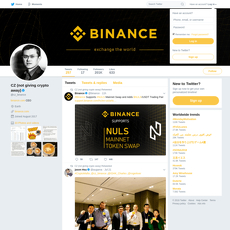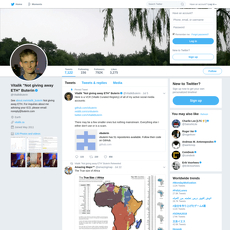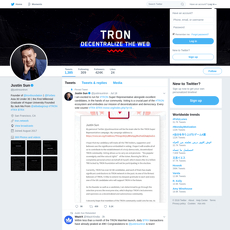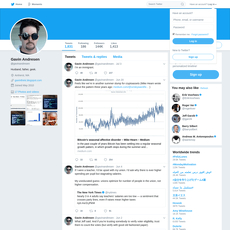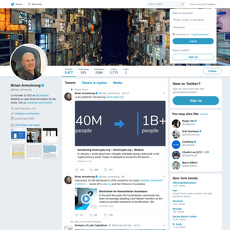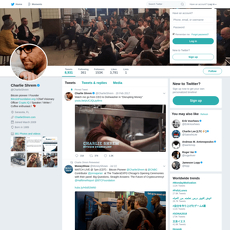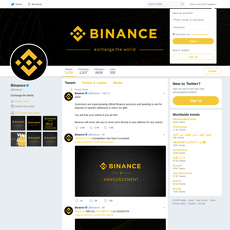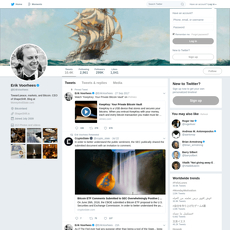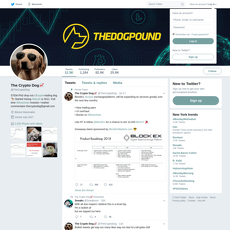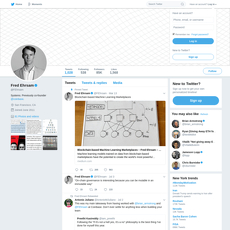Ryan Selkis Review
Ryan Selkis
twitter.com
Ryan Selkis Review Guide: Background, Best Threads, Investments, and an Honest FAQ
Ever scrolled crypto Twitter and thought, “Should I actually pay attention to Ryan Selkis?” Or is he just another loud voice in a noisy feed? Fair question—and worth answering if you care about signal over hype.
Here’s the deal: Ryan isn’t just posting hot takes. He blends policy, markets, and industry operations in ways that can actually help you—if you know how to read him. In this guide, I’ll show you a simple way to approach his posts, where his biases show up, and how to turn his threads into a practical edge.
Reminder: tweets are research leads, not trade signals. Treat them like prompts to do deeper work.
The pain: endless hot takes, zero clarity
Crypto Twitter is a firehose—ETF headlines one minute, regulatory drama the next, and endless threads that look important but don’t help you make better decisions. Ryan’s feed is high-volume and high-conviction, which can be great—or overwhelming—depending on how you filter it.
- Threads spiral into politics and dunking, and you lose the original point.
- Market calls show up without context or clear timeframes.
- Policy takes sound urgent—but you’re not sure what (if anything) to do with them.
- Quotes and replies create a maze that’s hard to piece together later.
This isn’t just anecdotal. Research shows noisy social feeds reward the most emotionally triggering content, not the most useful. One large-scale study found false news spreads significantly faster than true news on Twitter—driven by novelty and emotion, not accuracy (Science, 2018). And constant context switching is proven to degrade focus and recall over time (UCI research on interruptions and attention).
Point is: if you don’t have a reading framework, even smart voices can add to the confusion. Let’s fix that.
The promise: a simple, practical reading framework
My goal is to give you a clean way to read Ryan’s posts so you walk away with clarity, not FOMO. You’ll get:
- A three-lens filter to classify his posts quickly and avoid mixing narratives.
- Signals to trust (and warning signs to ignore), based on data use, timing, and source quality.
- Bias spotting so you can see where his role and investments might shape his takes.
- A workflow for turning his threads into research, watchlists, or decisions—without burning hours.
Who this guide is for
- Investors and traders who want policy and market structure context without drowning in takes.
- Builders looking for problem statements and category trends that actually map to product priorities.
- Analysts and researchers who value structured thinking and want a reliable way to synthesize his threads.
- Curious readers who want to understand why he matters without living on Twitter.
What you’ll walk away with
- A crisp understanding of his background and why his lens is unique.
- What typically shows up on his feed—and how to sort useful posts from noise.
- How to think about his investments and where to verify them.
- Where his strengths shine, where the blind spots are, and how to balance them.
- Practical tracking tips and a fast FAQ so you can move from reading to doing.
Ready to make his feed work for you instead of against you? Let’s start with the basics—who he is, why his perspective matters, and what to expect when you hit “Follow.” Curious what shaped his policy-first lens and market structure focus? Keep reading.
Who is Ryan Selkis? The quick background
Career snapshot and credibility
If you’ve been on crypto Twitter for more than five minutes, you’ve seen Ryan Selkis pop up as @twobitidiot. He isn’t just loud; he’s got the résumé to back it up. Before crypto, he built a traditional finance toolkit—then turned it toward an industry that needed structure and standards.
- Education: Boston College
- Early finance chops: Analyst experience at JPMorgan, then a venture role at Summit Partners
- First startup: Founded Good Benefits, a workplace giving platform
- Crypto operator: Founded Messari, the research and data platform many analysts, funds, and builders use to make sense of projects and policy
Messari isn’t just a blog. It’s known for structured asset profiles, disclosures, and industry reporting. If you’ve read the widely shared annual report Crypto Theses (example: Crypto Theses for 2024), you’ve seen the style: frameworks first, receipts included. That’s a big part of why his voice carries weight across trading desks, policy circles, and founder chats.
“In a market built on noise, context is a superpower. Get the context, and the noise stops owning you.”
Why his perspective matters
Ryan blends three lenses that rarely live in the same head: analyst discipline, founder reality, and policy urgency. That mix shows up in how he thinks about crypto’s next decade—less about shiny coins, more about infrastructure, rules of the road, and the systems that make the industry investable.
- Analyst thinking: He pushes for comparables, metrics, and footnotes. Expect scorecards, not vibes.
- Founder experience: He cares about go-to-market, team quality, and data plumbing—because he’s shipped product and managed teams.
- Policy advocacy: He’s vocal on U.S. regulation and market structure. You’ll see him rally the industry around legislation, disclosure standards, and ETF implications.
People often ask: is that just talk? Watch the receipts. When policy headlines shift, he connects them to liquidity, custody, and institutional access. When a project blows up, he points to the missing disclosure or broken incentive. That’s not accidents—that’s a consistent lens.
What to expect from his feed
If you follow @twobitidiot, you’ll get a stream that mixes market timing, policy action, and industry hygiene. It’s a blend of motivation and metrics. Some days it’s spicy; other days it’s spreadsheets and hearings.
- Policy pushes: Notes on legislation, enforcement postures, and why it matters for capital formation. When ETF or custody news hits, he’s usually early to frame the impact.
- Thesis threads: Sweeping market narratives tied to catalysts—L2 throughput, stablecoin rails, Bitcoin cycle liquidity. Look for time-stamped opinions and links to source docs.
- Project commentary: Takes on infrastructure, data standards, and operational excellence. Less “number go up,” more “can institutions rely on this?”
- Industry scorecards: He’ll highlight research from Messari—think sector maps, protocol updates, and quarterly reviews. It’s helpful if you’re tracking narratives over months, not hours.
Two real-world patterns I watch:
- Event-linked threads: Around hearings, ETF decisions, or big enforcement actions, his posts cluster with links and context. That’s when I open a fresh note and mark catalysts.
- Data-backed reframes: When sentiment overheats, he often re-centers on metrics: user funnels, validator health, L2 fees, treasury runways. It cuts through the noise and saves time.
There’s emotion in the feed—urgency, frustration, momentum—but it’s usually pointed at outcomes: better rules, stronger infra, cleaner data. That’s why I pay attention.
Want the easiest way to read his posts without getting lost? In the next section, I’ll give you a 30-second filter that sorts every tweet into the right mental bucket—and shows you what to ignore. Ready for a simple system that actually works?
How to read twobitidiot’s Twitter without getting lost
The three buckets: policy, markets, and industry ops
I read his feed by assigning every post to one of three labels the second I see it. It keeps me from mixing narratives and making messy decisions.
- Policy — regulatory updates, bills, hearings, agency moves. Think FIT21 votes, SEC posture, state-level pushes. If it affects rules of the game, it’s policy.
- Markets — liquidity, flows, ETF milestones, catalysts, cycle talk. If it moves price or positioning, it’s markets.
- Ops — how teams work, infrastructure standards, data quality, disclosure norms. If it changes how builders and analysts operate, it’s ops.
When I label on the fly, I know whether I’m reading for risk management (policy), timing (markets), or process (ops). No more whiplash.
“Strong signals show up with receipts: data, dates, and sources. Everything else is just noise dressed up as urgency.”
Thread signals vs. headline noise
Not all threads are equal. Here’s my quick filter to keep only the useful ones.
- Keep threads that include:
- Charts or tables with a source (Messari dashboards, on-chain data, ETF flow screens)
- Links to primary documents (SEC 19b-4 filings, congressional bill pages, court dockets)
- Time-stamped views (“Over the next 1–2 quarters…”, “By year-end if X passes…”)
- Clear falsifiers (“This breaks if BTC spot flows reverse 3 weeks in a row”)
- Skip posts that look like:
- Victory laps without data
- Quote-tweet feuds
- Vague “big news soon” teases
Fast trick: on X’s search bar, use from:twobitidiot filter:links to surface posts that usually have receipts, or from:twobitidiot min_faves:200 to catch posts the crowd found useful. Combine them: from:twobitidiot filter:links min_faves:200.
Timing matters
He tends to post around real catalysts. I keep a light calendar so I can separate hype from signal.
- Regulatory milestones
- U.S. House Financial Services and Senate Banking hearings (watch when SEC Chair testimony is scheduled; he’ll be loud and timely)
- Key bills and votes (example: FIT21 passed the House in May 2024 — his feed around that week is a policy goldmine)
- ETF events
- Bitcoin spot ETF approvals and early flow days (January 2024)
- Ethereum spot ETF S-1 effectiveness and launch week (July 2024)
- Industry releases
- Messari reports or standards pushes (expect coordinated threads, charts, and calls-to-action)
Why this works: behavior research shows that context switching destroys comprehension and recall. If I know a catalyst window is live, I read slower, save more, and skip the side chatter. Less scrolling. Better notes.
How to track themes over weeks, not hours
Twitter encourages short-term memory. I want compounding understanding. Here’s the simple system I use.
- Create a one-page rolling note for the month with three sections: Policy, Markets, Ops. Add only threads that passed the “receipts” test.
- Tag each entry with a horizon: this week, next month, next quarter. If there’s no timeframe, I add one based on the post’s content.
- Attach a falsifier in my own words: “This view fails if…” It forces me to hold opinions lightly.
- Set a 15-minute weekly review — spaced reviews dramatically improve retention (the classic Ebbinghaus curve and Bjork’s “desirable difficulties” both point to this). I update stances as new data arrives.
- Link to the primary source he cited (SEC filing, bill text, dashboard) so I’m not dependent on hot takes if the thread gets deleted.
Two quick, real-world examples of how this pays off:
- Policy example: During FIT21’s May 2024 push, I saved his policy threads and added the official bill page link. When the House vote cleared, I updated my note with which agencies would likely get scoped and what that meant for exchange token listings. That clarity shaped my risk settings the following week.
- Markets example: Around the Bitcoin spot ETF launch (Jan 2024), I flagged his posts that referenced early flow data and custodian routing. My falsifier was “three straight days of negative net flows.” When that didn’t materialize, I kept my playbook intact instead of panic-flipping narratives.
Extra filters I use on his feed
- Ops-first lens on messy news: If there’s drama, I look for a follow-up post with a process fix — disclosures, data standards, or infra gaps. If it’s there, it’s worth saving. If not, I move on.
- Primary source or pass: If a claim references policy or market structure without a link, I wait. Nine times out of ten, the primary doc answers my question faster than the replies.
- Mute keywords for sanity: I keep a small mute list (e.g., “scam,” “clown,” “L ratio”) so the quote-tweet battles don’t hijack my attention during catalyst weeks.
A mini checklist for fast reading
- Is this Policy, Markets, or Ops?
- Where are the receipts (chart, filing, bill, on-chain link)?
- What’s the timeframe he’s implying?
- What would invalidate this view?
- Do I need to act now, or should I save it for my weekly review?
If you use this simple framework, his feed turns from a firehose into a radar. And once you’ve got the radar tuned, the next question is obvious: when he puts actual money behind a theme, what does he pick — and why? Let’s look at the companies he’s backed and what that tells us about the road ahead.
Investments and portfolio themes: what he backs and why it matters
Notable companies he’s invested in (examples)
I track where he places chips because it’s the cleanest way to see his thesis in motion. Based on public announcements, a few standouts are:
Demox Labs (May 2023) — privacy-first wallet and identity tooling in the Aleo ecosystem, leaning into zero-knowledge UX.
Why it matters: smoother zk onboarding could unlock private onchain actions for real users, not just power devs.
twitter.com/DemoxLabs
Gateway (Jan 2023) — onchain identity, badges, and membership rails that plug directly into growth funnels and loyalty.
Why it matters: identity + reputation are the bridge from “addresses” to “audiences.”
twitter.com/gateway_xyz
Reown (Nov 2022) — wallet/auth SDKs with a UX-first mindset; think session security, account abstraction, and fewer user drop-offs.
Why it matters: every extra click kills conversion. If Reown removes friction, builders get compounding retention.
twitter.com/reownlabs
Spindl (Oct 2022) — web3 attribution and analytics so teams can measure real user acquisition, not just airdrop-farmed KPIs.
Why it matters: attribution is oxygen for marketing budgets. No clarity = no spend.
spindl.xyz • twitter.com/spindl_xyz
Dates above reflect public disclosures; always cross-check with the companies’ own posts or press.
“When you want to understand a voice in crypto, don’t chase the tweets. Follow the checks.”
How to interpret his investments
I treat these as thesis breadcrumbs. He tends to lean into infrastructure, tooling, and analytics that make crypto usable and measurable. In practice, that looks like:
- Infra resilience: wallets, identity, and zk rails that make the system sturdier and more private.
- Data clarity: attribution and analytics that turn hype into measurable funnels and budgets.
- User funnels: SDKs and loyalty layers that convert curious users into retained users.
There’s a pattern here: he backs the “picks and shovels” that compound over cycles. If he invests in a category, expect him to surface more research, founders, and policy angles around it. Not as a pump—more as an ongoing argument that “this is where the industry needs to level up.”
One thing I watch closely: attention vs. conviction. Social coverage around funding can drive short bursts of activity. That’s not unique to crypto—behavioral finance research shows attention shocks can influence near-term flows:
Barber & Odean (2008),
Da, Engelberg & Gao (2011).
I use that as a timing flag, not a thesis.
Where to verify and keep updated
I don’t guess—I verify. Here’s my quick stack for confirming investment notes and staying current:
- Company channels: official blogs and X posts are the first stop. Look for round announcements and investor lists.
- Funding databases: Crunchbase, PitchBook, and CB Insights for round details and co-investors.
- Research profiles: many projects maintain Messari profiles and “Disclosures” sections; cross-read those with company docs.
- Search operators: advanced X query like from:twobitidiot invest OR advisor OR angel plus project names to pull time-stamped mentions.
- Founder confirmations: founder threads and LinkedIn posts often tag angels and advisors—good for triangulation.
Using this info in your workflow
This isn’t about copying trades. It’s about sharpening your own map.
If you’re investing:- Map each company to a theme (identity, analytics, infra) and note the adoption metric that would prove it’s working (e.g., SDK installs, MAUs, retained cohorts, GMV tracked).
- Set attention guards. Funding day = narrative spike. Add to watchlist, but wait for second- and third-touch signals (hiring velocity, partner integrations, docs and SDK usage).
- Cross-compare with competitors. If Spindl is in the stack, what’s the delta versus Dune/Footprint/custom pipelines for your use case?
If you’re building:- Study the exact pain these startups attack. If wallets are still losing users at sign-in, your product should assume that and reduce steps.
- Adopt the tools. Shipping with a better auth SDK or attribution layer can lift conversion immediately—then you can prove it with your own data.
- Watch who co-invests. Strategic angels often open doors to design partners and early customers.
I keep a simple tracker: company, date, theme, core metric to watch, and a 90-day check-in note. It turns scattered tweets into a pipeline I can actually use.
“Signal isn’t loud. It’s consistent. Back the plumbing that compounds.”
But here’s the catch: everyone has strengths and blind spots—and those shape which bets get airtime. Want to know where his signal is strongest, and where you should add extra filters before acting?
Strengths, blind spots, and how to balance his takes
“Strong opinions are fine; strong evidence is better.”
Strengths you can bank on
Ryan Selkis (aka twobitidiot) has a few repeatable edges that consistently show up in his work and threads. When I’m scanning for signal, these are the anchors I trust:
- Clear frameworks, not just vibes. He’s good at organizing messy narratives into simple buckets (policy, markets, ops). His annual Messari-style scorecards and theses threads give you structure you can reuse across cycles. That consistency matters when news whiplash hits.
- Policy radar that actually moves markets. He spots and amplifies the high-impact stuff—SEC posture shifts, ETF milestones, and Congressional pushes like FIT21 and SAB 121 debates. The policy-to-liquidity pathway is real; Kaiko’s market microstructure research has shown how U.S. regulatory clarity correlates with venue volumes and spreads. When he’s loud on a pending vote or hearing, I set alerts.
- Market structure sense. He’s strongest when talking the plumbing: ETFs, custody, exchanges, compliance choke points, and how institutions route orders. That lens helps you avoid trading headlines that don’t translate to flow.
- Network effects. He’s plugged into founders, policy folks, and analysts. You’ll see early chatter around data standards, infra, identity/UX, and analytics—areas where his network overlaps with his investments and research.
Blind spots to keep in mind
Nobody’s coverage is complete. Here’s where I mentally discount or supplement what I’m reading:
- U.S.-heavy lens. Expect less frequent coverage of APAC liquidity shifts, EU implementation details, or on-the-ground adoption in Africa/LatAm. Reports like Chainalysis’ Geography of Crypto show outsized grassroots adoption in countries like Nigeria, Vietnam, and India—these trends can lead narratives before they show up in U.S.-centric feeds.
- Underweighted alt data and niche experiments. Great at scorecards and policy context, but you’ll sometimes see less granular on-chain for smaller ecosystems, bleeding-edge DeFi primitives, or non-traditional data sources. Pair his takes with dashboards on Dune or independent research from Glassnode and Coin Metrics.
- Global developer activity can be under the radar. The Electric Capital Developer Report has repeatedly highlighted developer growth in non-U.S. hubs. If you only track U.S. policy, you’ll miss where new dev momentum and tooling are compounding.
- Big Narrative gravity. When the conversation heats up—elections, “crypto vs. the establishment,” or “the next supercycle”—it’s easy for nuance to get lost. That’s not on him alone; it’s how social feeds work. Kahneman calls it “What You See Is All There Is”—we overweight what’s loud and recent.
How to balance the view
Balance isn’t about doubting everything—it’s about triangulating fast so you can act with fewer regrets:
- Pair policy with plumbing and price. Read Ryan for policy catalysts, then cross-check with liquidity and flow data (ETF creations/redemptions, basis, spreads). Good sources: Kaiko Research, The Block Data, and ETF provider dashboards.
- Add non-U.S. builders and analysts to your list. Follow teams operating in Asia, the Middle East, and LatAm for product traction, stablecoin usage, and new rails. You’ll catch shifts in user behavior before they hit Western feeds.
- Layer in on-chain and OSS telemetry. Use public dashboards (Dune, Token Terminal), GitHub commit heatmaps, and dev reports to validate “X is gaining adoption” claims. Evidence over echo.
- Keep a “contrarian mirror.” Before you act, actively search for smart people who disagree with his take. It’s a 5-minute bias check that saves you from narrative traps.
Practical filter
I run every high-signal Ryan thread through a 30-second checklist:
- What bucket is this? Policy, market, or ops. If it’s policy, I’m thinking timelines and probability. If it’s markets, I’m thinking flows and positioning. If it’s ops, I’m thinking teams, infra, and standards.
- Where’s the data? Links to primary sources, charts, or official statements. If it’s a claim about adoption/liquidity, I look for a chart or a source I can verify within minutes.
- What’s the timeframe? Hours, weeks, or cycles. A policy thread might be a weeks-long catalyst; an ETF flow note could be a days-long setup; an infra thesis is multi-quarter.
- What invalidates this? A clear null-hypothesis: the opposite vote outcome, a specific on-chain metric reversing, or a price/ratio breaching a level that contradicts the thesis.
Two quick real-world examples of how this filter helps:
- Policy alert (e.g., House vote on crypto market structure): Bucket = Policy. Data = committee schedule, whip counts, public statements. Timeframe = days to weeks. Invalidation = vote fails or the White House signals a veto with the votes to back it. Action = reduce tail risk, prepare post-vote playbook, not a blind trade.
- Market structure claim (e.g., “ETF flows will set the tone this month”): Bucket = Markets. Data = daily creations/redemptions, cumulative net flows, basis on CME, spot volumes by venue. Timeframe = weekly. Invalidation = flows stall or reverse for multiple sessions while price holds—signals another driver is in control.
You don’t need another loud voice—you need a clean process. Use Ryan’s strengths for what they are—frameworks, policy timing, and market plumbing—and patch the gaps with global builders and hard data.
Want to see the exact tools and alert setup I use to turn his threads into trade-ready notes and founder research queues? That’s next.
Get real value: how I use his insights as a reviewer and researcher
For investors and traders
I use Ryan Selkis (twobitidiot) as an early-warning system and a filter for what deserves research time. Here’s the playbook I actually run.
- Policy alert → risk posture: When he flags hearings, ETF windows, or enforcement shifts, I tag it as “policy” and immediately check primary sources (agency calendars, filings, official press pages). If it’s a real catalyst window, I reduce leverage, tighten stops, and widen my scenario tree for the next 48–72 hours. During the January 2024 spot BTC ETF approvals, this saved me from overtrading the rumor swarm and kept me positioned for the actual decision window.
- Cycle notes → entry/exit framing: His cycle threads often point to liquidity, macro narratives, and institutional flows. I translate those into triggers I can measure: funding flips, OI build-ups, ETF net flows, and DXY/UST yields. If he’s framing “liquidity on-ramps” or “risk-off,” I map that to clear invalidation levels so I’m not guessing off vibes.
- Project mentions → research queue: When he spotlights a category (e.g., infra, data standards, identity/UX), I don’t market buy anything. I add the tickers/tools to a watchlist, pull the latest on-chain and fundamentals, and run a 1-page memo: problem, user, traction, token role, runway. If it still looks strong after 72 hours, then it earns a position or a deeper dive.
- “One-tweet rule” I never break: I will not open or close a position off a single tweet—his or anyone’s. Tweets create attention; attention moves volatility. That’s different from conviction.
Quick evidence check: several peer‑reviewed studies have found short‑term links between social media attention and crypto returns/volume, and older work on markets shows Twitter mood can foreshadow volatility. I treat a viral Selkis thread as an attention proxy, never a standalone signal.
Example workflow (ETF window):
- He posts about a decision deadline → I confirm dates on the agency calendar.
- Tag it “policy,” size down leverage, and watch ETF flow trackers and implied vols.
- Set alerts for the hour around the decision, not the rumor days before.
- After the decision, I fade overreactions unless the flows confirm a new regime.
For founders and analysts
I read him like a customer interview—mining for problem statements, not product roadmaps.
- Spot the repeated pain: If he keeps hammering “data standards,” “governance hygiene,” or “infra reliability,” I translate that into backlog items. For protocols, that means predictable reporting, clean token distribution pages, and governance that isn’t a black box.
- Turn threads into specs: I’ll take one of his industry rants and write a 1-pager: what’s broken, who’s blocked, what the shortest measurable fix looks like. Then I compare that to user feedback and public dashboards to confirm it’s not just Twitter heat.
- Use Messari outputs as benchmarks, not law: His company’s reports and schema preferences are useful consistency guides. I don’t copy them; I ask, “What would make our disclosures or dashboards easier for an analyst to trust at a glance?” If you can answer that, you’ll win mindshare.
- Hiring and GTM edge: He’s a magnet for policy and infra talent. If he’s pushing a theme hard, I check who engages in the replies—often great candidates and champions are right there.
Founder checklist I use after a heavy Selkis thread:
- Is the problem he flagged on our roadmap in the next 2 sprints?
- What’s the smallest public artifact we can ship (dashboard, spec, post) to build trust?
- Which metric moves if we fix it—retention, LTD, developer activity, governance turnout?
- Who are 3 non‑US voices validating or challenging this take?
Tools and links I keep handy
My setup is boring but fast—exactly what you want when noise spikes.
- Twitter Lists: separate lists for Policy, Market Microstructure, and Builders. I pin them and scan in that order so narratives don’t bleed together.
- Event alerts: Calendar pings for known ETF decision windows, hearings, and major releases. I turn on Selkis notifications only for those windows to avoid constant distraction.
- Smart search: Saved searches like from:twobitidiot (ETF OR SEC OR “hearing” OR “policy”) and another for (“data standards” OR “disclosures” OR “governance”). This surfaces threads I actually act on.
- Thread archive: I clip key threads into a simple notes doc with a date, bucket (policy/markets/ops), and a “what would change my mind?” line. Revisit monthly and prune ruthlessly.
- Resources I keep open while reading: Tools, trackers, and primary sources.
What I watch for next
I’m tracking a few lanes where his signal tends to be early:
- Policy catalysts: stablecoin rules, staking/tax guidance, cross‑agency turf changes. If he frames a credible timeline, I prep volatility plans ahead of the news cycle.
- Market structure shifts: new on‑ramps (ETFs, RWA rails), custody standards, and liquidity migration. I map his takes to hard data—flows, spreads, and depth—before changing positioning.
- New investments: if he branches beyond infra/analytics into consumer or privacy, I’ll expand my watchlist and talk to users in those niches the same week.
- Messari releases: annual theses and sector maps often reframe narratives. I pull out 3 actionable themes and set one experiment per theme—ship or scrap within two weeks.
Want the fast answers I get asked all the time—what he’s invested in, how to set the perfect alert stack, and how I quickly score a Selkis thread in five seconds? That’s coming up next, and it’ll make your feed feel a lot lighter.
FAQ and wrap-up: everything you need to know, fast
Here’s the short, useful version. If you want policy awareness, market structure context, and a window into infra/data trends, following Ryan Selkis (aka twobitidiot) can pay off—if you filter it right. Below are the questions I get the most, answered with quick context and examples you can actually use.
What companies has Ryan Selkis invested in?
Public examples often cited include:
- Demox Labs (May 2023) — privacy-first tooling (e.g., Leo Wallet on Aleo); signals interest in ZK-driven infra and user-facing security.
- Gateway (Jan 2023) — tools around identity/UX and onchain access; suggests a focus on adoption bottlenecks.
- Reown (Nov 2022) — identity/UX stack; points to better wallet flows and safe authentication.
- Spindl (Oct 2022) — web3 attribution/analytics; aligns with his push for cleaner data and measurable growth.
How to stay accurate: always verify with the company’s official announcement, a press release, or a profile page before you act. Cross-check sources like company blogs, funding databases (e.g., Crunchbase), and project documentation. Treat these as thesis breadcrumbs, not a trade signal.
What is Ryan Selkis’ background?
Short version: Boston College grad → JPMorgan (analyst) → Summit Partners (venture) → founded Good Benefits (workplace giving platform) → founded Messari. That mix explains the blend of analyst rigor, founder urgency, and policy advocacy in his posts. Expect commentary on U.S. crypto policy, market structure, cycles/liquidity, and industry scorecards.
How do I get the most from his Twitter?
- Use a 3-bucket filter: label posts as policy, markets, or ops (industry operations). Your brain will stop mixing narratives.
- Save only data-backed threads: keep the ones with charts, links to primary sources (hearings, filings, reports), and clear timeframes.
- Time your attention: turn on alerts for hearings, ETF news, and big Messari releases. That’s when signal density spikes.
- Balance the lens: pair his feed with non-U.S. builders, technical researchers, and on-chain analysts so you’re not stuck in one narrative.
- Treat tweets as leads, not trades: capture the idea, then validate with independent research before you move a dollar.
Heads-up: Trading off headlines tends to underperform. See Barber, Huang, Odean, and Schwarz’s research on “attention-induced trading” and weaker returns for retail following hype events (SSRN).
Final take: how I rate following twobitidiot
Net positive if you want policy context, institutional-grade market structure thinking, and a pulse on infra/data trends. Caveat: he’s U.S.-policy loud and big-narrative heavy, so balance it with non-U.S. and technical viewpoints.
The way I keep it useful is simple: filter by category, save only evidence-backed threads, verify claims, and add his investment categories to a watchlist rather than FOMO trades. That’s exactly how I run it on Cryptolinks.com—and it keeps the signal high and the stress low.
CryptoLinks.com does not endorse, promote, or associate with Twitter accounts that offer or imply unrealistic returns through potentially unethical practices. Our mission remains to guide the community toward safe, informed, and ethical participation in the cryptocurrency space. We urge our readers and the wider crypto community to remain vigilant, to conduct thorough research, and to always consider the broader implications of their investment choices.


